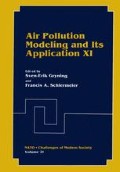Abstract
A second order closure model is applied to the transport of chemical reactive gases in the convective boundary layer. The importance of concentration correlations on the mean transformation rate is studied. The relevance of chemistry terms in the flux equation and covariance equations is assessed. Two different cases are shown: case 1 with two reactive species released from the surface, and case 2 with a top-down and a bottom-up tracer. For case 1 it was found that the covariance of both reactive species is either positive or negative, increasing or reducing the effective transformation rate depending on the Damköhler number (the ratio of the turbulent timescale and the chemistry timescale). In case 2 the concentration covariance reduces the effective transformation rate by 30% for slow and by 75% for fast chemistry. A significant influence of chemistry on the flux is found in both cases, mainly due to chemistry effects on the buoyancy term.
Access this chapter
Tax calculation will be finalised at checkout
Purchases are for personal use only
Preview
Unable to display preview. Download preview PDF.
References
André, J. C., P. Lacarrère and K. Traoré. 1982. Pressure effects on triple correlations in turbulent convective flows. Turbulent Shear Flows, Ed. Bradbury et al. 3, 243–152.
André, J. C., G. De Moor, P. Lacarrère, G. Therry and R. Du Vachat. 1978. Modelling the 24-hour evolution of the mean and turbulent structures of the planetary boundary layer. J. Atmos. Sci. 35, 1861–1883.
Fitzjarrald, D. R., and D. H. Lenschow, 1983. Mean concentration and flux profiles for chemically reactive species in the atmospheric surface layer. Atmos. Environ., 17, 2505–2512.
Gao, W. and M.L. Wesely, 1994. Numerical modelling of the turbulent fluxes of chemically reactive trace gasses in the atmopheric boundary layer, J. Appl. Meteor., 33, 835–847.
Garratt, J.R., 1992. The Atmospheric Boundary Layer. Cambridge University Press.
Holtslag, A. A. M. and C.-H Moeng. 1991. Eddy diffusivity and countergradient transport in the convective atmospheric boundary layer. J. Atmos. Sci. 48,(14): 1690–1698.
Lenschow, D. H., J. C. Wyngaard and W. T. Pennell. 1980. Mean-field and second-moment budgets in a baroclinic, convective boundary layer.J. Atmos. Sci. 37, 1313–1326.
Mellor, G.L. and T. Yamada. 1974. A hierarchy of turbulent closure models for planetary boundary layers. J. Atmos. Sci. 31, 1791–1806.
Moeng, C.-H and J. C. Wyngaard. 1989. Evaluation of turbulent transport and dissipation closures in second-order modelling. J. Atmos. Sci. 46, 2311–2330.
Schumann, U. 1989. Large-eddy simulation of turbulent diffusion with chemical reactions in the convective boundary layer. Atmos. Envir., 23, 8,pp. 1713–1727.
Sorbjan, Z., Structure of the Atmospheric Boundary Layer. 1989, Prentice-Hall, New Jersey.
Vilà-Guerau de Arellano, J. and P.G. Duynkerke. 1992. Influence of chemistry on the fluxgradient relationships for the NO-O3-NO2 system. Boundary-layer Met. 61, 375–387.
Author information
Authors and Affiliations
Editor information
Editors and Affiliations
Rights and permissions
Copyright information
© 1996 Springer Science+Business Media New York
About this chapter
Cite this chapter
Verver, G. (1996). Turbulent Mixing of Reactive Gases in the Convective Boundary Layer. In: Gryning, SE., Schiermeier, F.A. (eds) Air Pollution Modeling and Its Application XI. NATO · Challenges of Modern Society, vol 21. Springer, Boston, MA. https://doi.org/10.1007/978-1-4615-5841-5_37
Download citation
DOI: https://doi.org/10.1007/978-1-4615-5841-5_37
Publisher Name: Springer, Boston, MA
Print ISBN: 978-1-4613-7678-1
Online ISBN: 978-1-4615-5841-5
eBook Packages: Springer Book Archive

